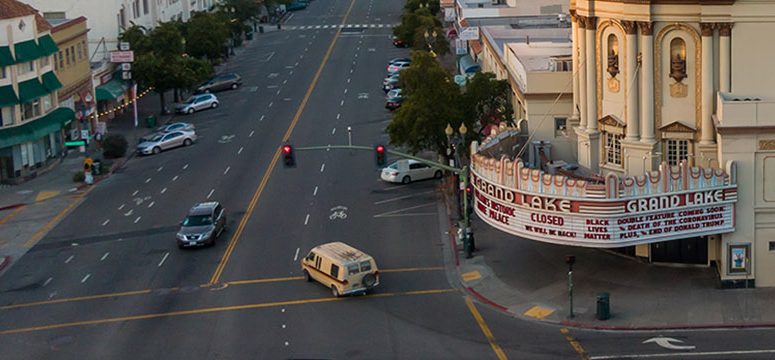 Widening the median on Divisadero Street. Photo: Janel Sterbentz
Widening the median on Divisadero Street. Photo: Janel SterbentzNinety years after city traffic managers widened Divisadero Street between Haight and Sacramento Streets, skimming off five feet of sidewalk and adding a travel lane on both sides, the Department of Public Works (DPW) is spending $3.3 million to upgrade the landscaping on the median, without adjusting the skinny nine-foot-nine-inch sidewalks. The DPW recently started construction on the project on Divisadero between Waller Street and Geary Boulevard, where it will add new bus bulb-outs, widen the median and plant trees on it, upgrade lighting fixtures, plant new sidewalk trees and install other furnishings.
Many residents from the neighborhoods Divisadero connects are relieved to see any pedestrian improvements, given the long neglected state of the street.
"I think that street has been so beleaguered and so worn down for so many years, people are going to be happy just to get any improvement," said BIKE NOPA's Michael Helquist. Leela Gill, former president of the North of Panhandle Neighborhood Association, called the project "a welcome improvement."
Wider sidewalks were high on the list of requests at community feedback meetings, but DPW ruled them out during the planning process, said Walk SF's Manish Champsee. "It comes down to a cost issue," said Champsee.
Whenever the city widens sidewalks, it must also move fire hydrants within two feet of the new curb; utilities and sewers also must be moved. Champsee would like the city to find a way to simplify the process, which might mean simply leaving everything in place when the sidewalks are widened and moving it all later when when individual components are scheduled for regular maintenance.
Coordinating scheduled work between DPW and the Public Utilities Commission is not always easy, said Livable City's Tom Radulovich, because the PUC does not publish a road map of scheduled maintenance like DPW does. The result is that DPW often prefers median widening to sidewalk
widening when there's excess roadway space and funds available to make
upgrades, since median widening is much simpler and cheaper.
 Before installation of a pedestrian refuge island. Photo: Janel Sterbentz
Before installation of a pedestrian refuge island. Photo: Janel Sterbentz On another block of Divisadero, after installation of a pedestrian refuge island. Photo: Janel Sterbentz
On another block of Divisadero, after installation of a pedestrian refuge island. Photo: Janel SterbentzNeighbors, desperate for any pedestrian and aesthetic improvements, were willing to compromise. That might preclude an eventual road diet, said Radulovich, who would have preferred to "do fewer blocks but do them right," like the four-block Valencia Streetscape Improvement Project. Since expensive new lights are being added to the widened Divisadero median, the city might be hesitant to tear part of the median out later, a near-necessity if Divisadero were ever to receive a road diet. To do that, said Radulovich, the city would need to remove a travel lane in each direction and install a left-turn-only lane at intersections, cutting into the expensive new median.
Divisadero's nine-foot-nine-inch sidewalks don't comply with the draft Better Streets Plan guidance on commercial thoroughfares like Divisadero, and until that plan is completed and implemented, it's a shortcoming that could be repeated often. In the case of Divisadero, it means that while there's no shortage of draws bringing foot traffic to the street these days, an end to its 90-year legacy of skinny sidewalks is still a long way off.





